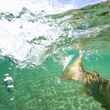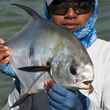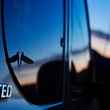I’m the minority in age and gender at this show, but I don’t mind. I know a majority of the faces at the East Idaho Fly Tying and Fly Fishing Expo and they all have a smile and story for me. I talk hockey with Arn, drones with Roger and beer with Lonnie. All this before I make it halfway around the fly tying tables.
I move as I talk because I’m looking for a particular tier. Doug Burton. I met him on Utah’s Green River six years ago. He makes it to my neck of the woods about as often as I make it to his. Once a year. He drives 12 hours round trip to sit at a table among rows of tables and tie flies among a mass of other fingers tying flies. I find him in the middle aisle. He’s fiddling feathers and thread into what he calls the royal family.
“I could just tie all kinds of royals,” Burton says. “I ended up with 14 for this show and I said you gotta quit.”
Burton started tying at the expo in 2005. He isn’t paid to be at the show. He pays (gas, food, lodging) to be at the show. He almost quit showing last year because of the expense. Then a thank-you note arrived.
“Once in a while you have a year when you say this was a lot of trouble,” Burton says. “Then you get a letter showing you how much the show raises for conservation. I decided it’s worth the expense to me if doing my part helps raise that kind of money.”
More Like This
The East Idaho Fly Tying and Fly Fishing Expo, in its 24th year, is put on by Federation of Fly Fishers and Trout Unlimited’s Snake River Cutthroat chapter. Twenty-five staffers and 100 volunteers prep six months in advance for the April show that has raised $324,000 for fisheries work in the last 13 years. That money fixes fish screens, connects tributaries and teaches kids to cast.
“The thing I’m most proud of is a lot of people pull in a lot of professionals to do what we’re doing,” says Arn Berglund, East Idaho Fly Tying and Fly Fishing Expo chairman. “We’re volunteers and we’re doing this for the love of fishing and cold water conservation.”
Tom Sadler works the show circuit on the East Coast. He’s a Tenkara fishing guide for Mossy Creek Fly Fishing in Virginia. Somerset, New Jersey is the largest show he attends, along with 13,150 other people over three days in January.
“It’s a lot of work to go to shows,” Sadler says. “We leave at sunrise, drive six hours to Somerset, set up the booth Thursday and hit the ground running Friday morning.”

The Somerset Show, in its 25th year, is put on by The Fly Fishing Show, which is in the professional business of coordinating seven other shows across the country. The company donates nearly $100,000 of its show revenue annually to fish-related conservation. This year’s proceeds are going to American Rivers Anglers Fund and American Fly Fishing Trade Association (AFFTA) Fisheries Fund.
AFFTA also donates $35,000 annually to its Fisheries Fund from its own trade show, the International Fly Tackle Dealer show. The Fisheries Fund is distributed nationwide for initiatives like stream access in Utah and channel markers in the Everglades. Beyond actual money for conservation, shows also donate booth space to non-profits.
“The biggest part of it isn’t the money we donate. It’s the exposure,” says Ben Furimsky, The Fly Fishing Show president and CEO. “Non-profits tell us being at our show is their biggest fundraiser of the year or their biggest membership drive of the year. The amount of exposure they get is tremendous.”
That exposure has a cascading effect. It’s impossible to move through the fishing world without realizing what kind of world is needed to keep fishing afloat.
“People come to fish and they walk away conservationists because that’s the ethos of fly fishing in so many ways,” Sadler says. “You can’t help but get introduced to conservation just based on the stickers on the back of fisherman’s trucks. They’re going to move in that direction if they stay in the fly fishing world.”
A world full of conservation and color. Burton’s beautiful, red, royal family will do a number on the water while the money raised during the time he tied it will do a number on the water in many other ways via non-profits.
“If you want to see efficiency in conservation, turn to non-profits,” Berglund says. “All of the boots-on-the-ground organizations are made up of people who enjoy what they’re doing, want to protect it and are willing to put in the time to do it.”































Comments